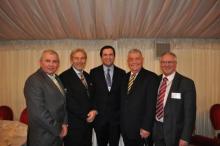ASFP reaches out to wider community
ASFP reaches out to wider community
Speaking to a capacity audience at the ASFP’s President’s Lunch, held at the House of Lords on 7 December, Mr Robinson explained that educating those that design, manage, supply, install, inspect and maintain passive fire protection throughout the built environment is crucial to minimising the devastating impact of fire in our communities.
“This really is not rocket science, but until fire protection is appreciated as a vital skill within the construction process in its own right, as opposed to an add-on within the portfolio of other trades, then we will continue to see substandard workmanship within the built environment,” he declared.
Mr Robinson announced that, the ASFP has obtained a significant grant from the CITB-ConstructionSkills Growth Fund to develop a nationally recognised industry training scheme for passive fire protection.
The programme, which is being developed in conjunction with the Fire Protection Association, aims to up-skill all those involved in the installation of passive fire protection and improve the knowledge base of those involved in the design, supply, inspection and maintenance of passive fire protection.
With a pilot scheme due to be launched in 2013, Mr Robinson said that the course will have a fundamental impact on improving the quality of the future built environment and ensuring that fire safety is maintained.
“This is very ambitious project but one we feel to be essential if we are to raise the bar in appropriate passive fire protection awareness and quality of workmanship, and in the process create essential industry benchmark standards to be recognised as industry norms,” he said.
Mr Robinson also revealed that the ASFP is reaching out to communities outside of the UK, with the introduction of a training programme in Ireland. Supported by ASFP member Exova Warringtonfire, ASFP Ireland has made significant strides in raising awareness of the importance of appropriate passive fire protection and, in particular, the essential need for third party certification. The courses which target passive fire protection installers and risk assessors are also being piloted by Ireland’s Health Service Executive.
While recognising the dedication of the ASFP in reaching out to the wider community, Mr Robinson highlighted the Association’s continued commitment to working with others within the fire sector, through the Fire Sector Federation (FSF).
He explained that the Fire Sector Federation now represents almost 40 organisations and companies from across the sector and has formed 13 workstreams, covering such issues as Technical Guidance, Fire Investigation, International Liaison and Enforcement.
“I think it fair to say that many of the old battle fields such as the warring trade-offs between the passive and the active sectors are now being assigned to history in recognition of the need for a more ‘balanced’ approach to appropriate fire protection measures,” he declared.
“There is now clear and certain recognition that each aspect of the fire protective process has a rightful role to perform, and trading one solution for another is more akin to putting self-interest above fire safety.”

